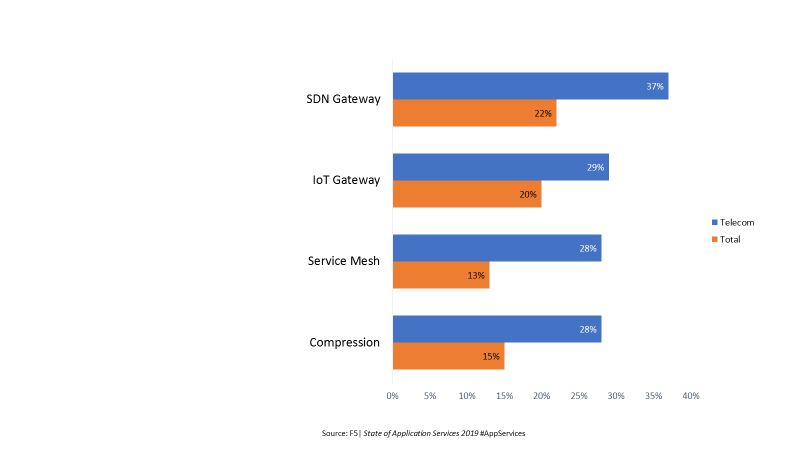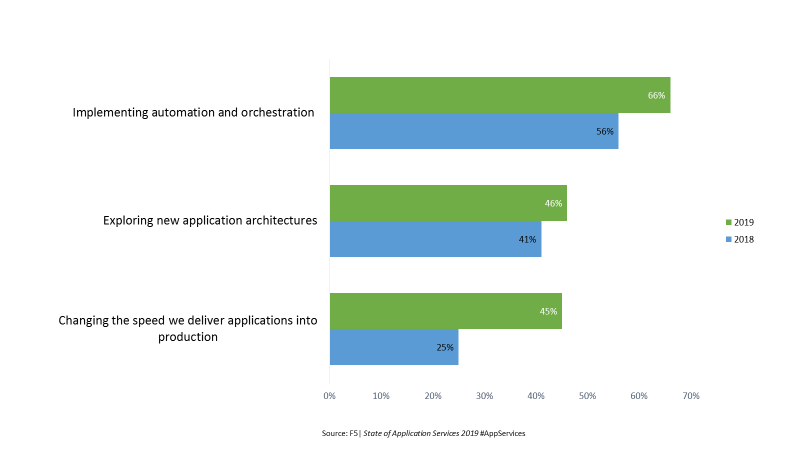アプリケーション サービス テレコム版の現状: リーダーとして台頭する
2019 年のアプリケーション サービスの現状調査では、通信業界がデジタル経済を活用して 5G に移行するために、アプリケーション サービスをどのように実装しているかについての洞察が提供されます。 通信ネットワークがさまざまな業界のさまざまなユースケースをサポートするように進化するにつれて、通信業界の回答者がリーダーとしての技術プロファイルを高めていることが分かります。 通信業界の回答者の 5 人に 4 人 (80%) がデジタル変革を実行しており、これは世界の調査対象者全体の 69% を大きく上回っています。 通信業界の回答者は、技術投資だけでなく、構造、プロセス、ワークフローの再評価もリードし、総所有コストを削減するとともに、より機敏な方法論を採用しています。 単一機能(サイロ化)の IT チームからの移行が最初のステップであり、調査対象者全体の 55% と比較して、通信業界の回答者の 58% がこの変化を受け入れていることがわかりました。
回答者の 60% がコンテナを採用しており、アプリケーション サービスの新たな展開を先導しています。
通信業界の回答者はコンテナの導入で同業他社をわずかに上回っており、調査全体の 56% に対して 5 社中 3 社 (60%) となっています。 さらに注目すべきは、通信業界の回答者が新しいアプリケーション サービスをどのように取り入れているかという点で他社と一線を画している点です。 通信業界で導入が計画されている上位 4 つのアプリケーション サービスは、SDN ゲートウェイ、IoT ゲートウェイ、サービス メッシュ、圧縮です。 コンテナの台頭により、後者 3 つの導入計画が促進され、圧縮はネットワーク コストを削減しながら肯定的な顧客エクスペリエンスを維持する必要性を物語っています。 通信事業者のトップ 4 を見ると、それらのアプリケーションと全人口向けのプランとの間に大きな違いがあることがわかります。

アプリケーション サービスにより、通信プロバイダーは、適用される規制やより広範な社会環境を十分に理解した上で、消費者、商業、政府機関の顧客に対する責任を果たし、常時接続のネットワーク サービスを提供できるようになります。 その結果、通信事業者は、平均 17 個のアプリケーション サービスを導入しており、導入しているアプリケーション サービスの幅広さにおいて同業他社よりも一歩先を進んでいます。 すべての業種において、20 を超えるアプリケーション サービスを導入している回答者はわずか 27% でしたが、通信業種では 40% が 20 を超えるアプリケーション サービスを導入していると報告しました。
回答者の 71% が自動化とオーケストレーションの取り組みを導入しており、開発者向けのソリューションが先頭に立っています。
自動化とオーケストレーションは、通信事業者にとってネットワークの効率的な管理に不可欠なものになります。 クラウドベースのマイクロサービス アーキテクチャは 5G の俊敏な提供に不可欠ですが、自動化とオーケストレーションによってのみ、オペレーターは必要な規模に対応しながら同時に運用コストを削減することができます。 回答者にデジタルトランスフォーメーションがアプリケーションの決定にどのような影響を与えているかを尋ねたところ、通信業界の回答者は「自動化とオーケストレーションの実装」を最も多く挙げ、その割合は2018年の56%から2019年には66%に増加しました。

さらに、通信業界の回答者は調査対象者全体をわずかに上回っており、現在自動化とオーケストレーションを導入している割合は全体の 68% に対して、71% となっています。
SDN と NFV により、通信会社はネットワーク ドメインを仮想化し、ネットワーク上の膨大な量に対応するだけでなく、従来は静的だったポイントツーポイントから、IoT やクラウド ワークロードのより動的でリアルタイムな要件へのトラフィック パターンの変化にも対応できるようになります。 ネットワークの稼働時間が通信事業者にとって主な要件だった頃は、必ずしも新しいテクノロジーを試す必要のない、はるかに単純な方程式でした。 しかし、特に 5G に関しては、そのプロファイルは変化しています。 ネットワーク リソースがネットワーク需要に応じて拡大および縮小する世界では、収益性の高いサービスはクラウドベースのマイクロサービス、自動化、オーケストレーションによってのみ実現されます。つまり、通信ベンダーを明日のテクノロジー リーダーとして迎え入れるには今が最適な時期なのです。
